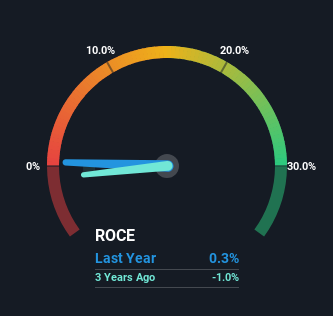Kader Holdings (HKG:180) Could Be Struggling To Allocate Capital
If you're looking at a mature business that's past the growth phase, what are some of the underlying trends that pop up? When we see a declining return on capital employed (ROCE) in conjunction with a declining base of capital employed, that's often how a mature business shows signs of aging. Ultimately this means that the company is earning less per dollar invested and on top of that, it's shrinking its base of capital employed. In light of that, from a first glance at Kader Holdings (HKG:180), we've spotted some signs that it could be struggling, so let's investigate.
Understanding Return On Capital Employed (ROCE)
If you haven't worked with ROCE before, it measures the 'return' (pre-tax profit) a company generates from capital employed in its business. Analysts use this formula to calculate it for Kader Holdings:
Return on Capital Employed = Earnings Before Interest and Tax (EBIT) ÷ (Total Assets - Current Liabilities)
0.0034 = HK$7.7m ÷ (HK$3.0b - HK$791m) (Based on the trailing twelve months to June 2023).
Thus, Kader Holdings has an ROCE of 0.3%. Ultimately, that's a low return and it under-performs the Leisure industry average of 8.1%.
View our latest analysis for Kader Holdings

Historical performance is a great place to start when researching a stock so above you can see the gauge for Kader Holdings' ROCE against it's prior returns. If you'd like to look at how Kader Holdings has performed in the past in other metrics, you can view this free graph of past earnings, revenue and cash flow.
What Does the ROCE Trend For Kader Holdings Tell Us?
In terms of Kader Holdings' historical ROCE movements, the trend doesn't inspire confidence. To be more specific, the ROCE was 5.6% five years ago, but since then it has dropped noticeably. Meanwhile, capital employed in the business has stayed roughly the flat over the period. Companies that exhibit these attributes tend to not be shrinking, but they can be mature and facing pressure on their margins from competition. So because these trends aren't typically conducive to creating a multi-bagger, we wouldn't hold our breath on Kader Holdings becoming one if things continue as they have.
Our Take On Kader Holdings' ROCE
In summary, it's unfortunate that Kader Holdings is generating lower returns from the same amount of capital. Investors haven't taken kindly to these developments, since the stock has declined 60% from where it was five years ago. That being the case, unless the underlying trends revert to a more positive trajectory, we'd consider looking elsewhere.
One final note, you should learn about the 3 warning signs we've spotted with Kader Holdings (including 1 which is a bit concerning) .
If you want to search for solid companies with great earnings, check out this free list of companies with good balance sheets and impressive returns on equity.
Valuation is complex, but we're here to simplify it.
Discover if Kader Holdings might be undervalued or overvalued with our detailed analysis, featuring fair value estimates, potential risks, dividends, insider trades, and its financial condition.
Access Free AnalysisHave feedback on this article? Concerned about the content? Get in touch with us directly. Alternatively, email editorial-team (at) simplywallst.com.
This article by Simply Wall St is general in nature. We provide commentary based on historical data and analyst forecasts only using an unbiased methodology and our articles are not intended to be financial advice. It does not constitute a recommendation to buy or sell any stock, and does not take account of your objectives, or your financial situation. We aim to bring you long-term focused analysis driven by fundamental data. Note that our analysis may not factor in the latest price-sensitive company announcements or qualitative material. Simply Wall St has no position in any stocks mentioned.
About SEHK:180
Kader Holdings
An investment holding company, manufactures and trades plastic, electronic and stuffed toys, and model trains in Hong Kong, Mainland China, North America, Europe, Japan, Singapore, and internationally.
Good value with imperfect balance sheet.
Market Insights
Community Narratives



